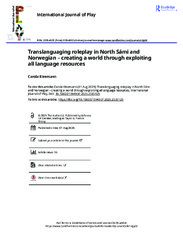| dc.description.abstract | Roleplay is structured through stylised language practices. Children engaging in roleplay are aware of the various levels of reality distinguishing play from the real world. To mark these levels, they use signals, or metacommunication, to convey the meaning ‘this is play’. Within roleplay, these levels are expressed through distinct utterance types: directive utterances, role utterances, magical utterances, and out-of-play utterances. Bilingual children draw on their entire linguistic repertoire to signal these distinctions, using contextualisation cues. This article is based on video recordings of child-to-child interactions involving 15 children, aged 3–6, during unsupervised roleplay observed in a Sámi kindergarten, where the children spoke both North Sámi and Norwegian. A Conversation Analysis (CA) approach was used for transcription conventions, alongside an ethnomethodological analysis of the children's methods, to derive local interpretations of the codes in their bilingual roleplay. The children used both languages within their unique stylised bilingual roleplay, consisting of codified utterance types signifying different levels of reality. Consequently, code-switching occurred between utterance types, while the blending of named languages in their stylised performance exemplified spontaneous translanguaging. | en_US |


 English
English norsk
norsk
